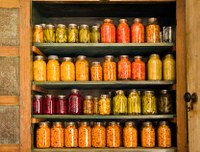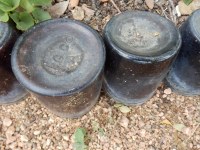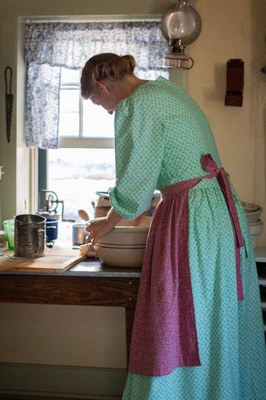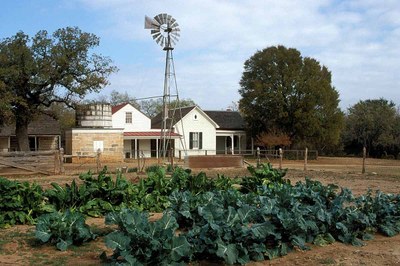Sauer-Beckmann Farm
Experience life on the Sauer-Beckmann Living History Farm. When you smell dinner cooking on a wood-burning stove, you are almost here!
 Park rangers wearing historical clothing work the farm. Daily chores include caring for animals – feeding, milking, gathering eggs and slopping hogs. Inside the house, cooking, cleaning and churning need to be done. You might see “family” members weeding the garden, working in the blacksmith shop, or knitting. Seasonal chores include canning and butchering.
Park rangers wearing historical clothing work the farm. Daily chores include caring for animals – feeding, milking, gathering eggs and slopping hogs. Inside the house, cooking, cleaning and churning need to be done. You might see “family” members weeding the garden, working in the blacksmith shop, or knitting. Seasonal chores include canning and butchering.
The rangers’ main job, however, is to talk about life on this farm and answer your questions.
Keep in touch with Sauer-Beckmann Living History Farm on Facebook.
The Sauers
Johan Friedrich Sauer and his wife Christine Strackbein purchased 188.75 acres along the Pedernales River from Casper Danz and moved here with their four children in 1869. They built a log and rock cabin for the family, with a sleeping loft and a porch facing south. As their family grew, they added rooms to the original structure. By 1885, they completed a two-story stone dormitory for their 10 children.
They also built the smokehouse and tank house. The Sauers farmed and raised cattle and sheep. In subsequent years, they bought more land.
The Sauers sold their farm to Hermann Beckmann in 1900 and moved to be near their sons in Doss. Johan died in 1909, and Christine died in 1910.
The Beckmanns
Herman Beckmann bought about 400 acres of the Sauer land for his sons, Otto and Emil. He paid $4,450 (about $11 per acre). The sons lived and worked on the farm to repay their father.
Emil married Emma Mayer in 1907 and they set up housekeeping on the farm. The Beckmanns raised three children there – Rubin, Elgin and Edna.
The Beckmann brothers began planting cotton, and 1915 was a banner year for them. Cotton prices went from 9 to 20 cents a pound in one month. With their cotton money, Emil and Emma bought out Otto’s share in the farm and began making improvements.
 They built a new barn, added a frame room onto the two-story stone structure, and built the Victorian house connected to the older structure by a large “Durchgang” (hallway). A swept yard and flower beds outlined with 24-ounce beer bottles surrounded the house.
They built a new barn, added a frame room onto the two-story stone structure, and built the Victorian house connected to the older structure by a large “Durchgang” (hallway). A swept yard and flower beds outlined with 24-ounce beer bottles surrounded the house.
The family sold pieces of the land over the years, including four acres to President Lyndon B. Johnson in 1951. Emma Beckmann gave the remaining acreage to her daughter Edna and husband Ernest Hightower in 1959.
Edna Beckmann Hightower sold the site to TPWD in 1966.

- Photo courtesy of Sara Moses
Tours
Tours are free, but donations are welcome. Tours are self-guided, with rangers and volunteers on hand to answer questions.
The farm is open daily except on Thanksgiving, Christmas, New Year's Day and the last Tuesday of every month.
- (Oct.- May) 10 a.m. - 4 p.m.
- (June - Sept.) 9 a.m. - 3 p.m.
Visit the park virtually by exploring our 360° photos.

